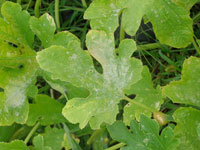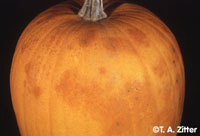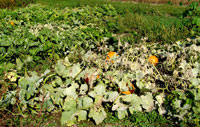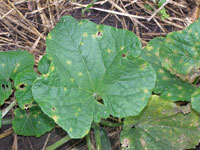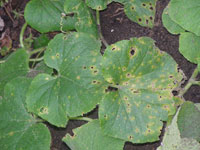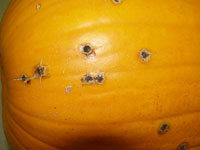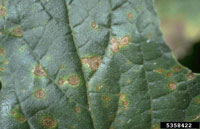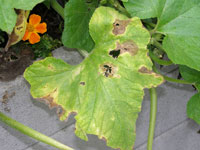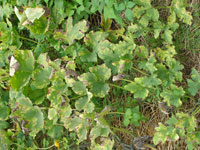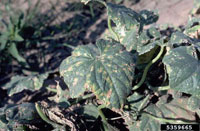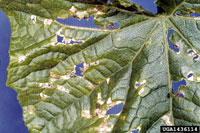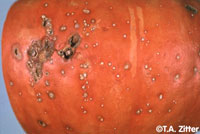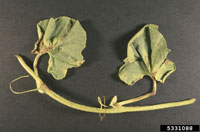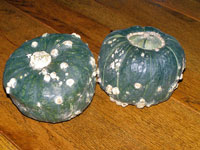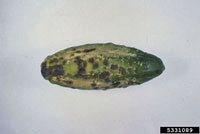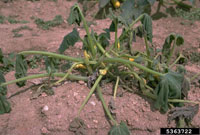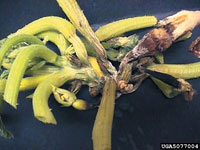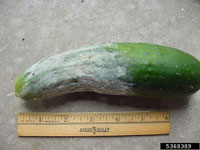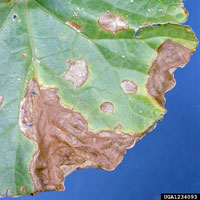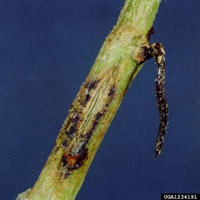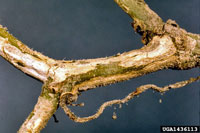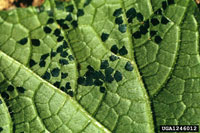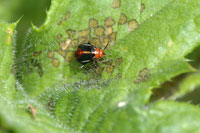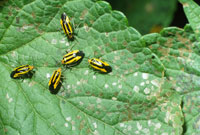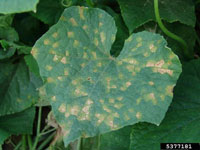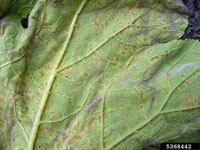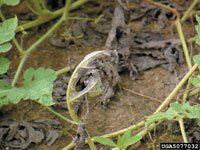Extension > Garden > Diagnose a problem > What's wrong with my plant? > Vegetable > Cucumber > Spots on leaves
Cucumber > Leaves > Spots on leaves
1 of 9
Powdery Mildew
Podosphaera xanthii
- Initially pale yellow spots develop on the oldest leaves
- White to gray powdery felt in spots, blotches or complete covering of leaves
- Lesions develop on underside of leaves, or on shaded leaves first
- Older leaves infected first
- Severe infection can cause leaves and vines to wither and die
- Fruit may be blotchy or have sunscald
- More information on Powdery Mildew
2 of 9
Anthracnose
Colletotrichum obriculare
- Somewhat circular dry brown leaf spots form near veins
- Center of leaf spot often falls out, leaves appear ‘shot hole’
- Circular sunken dark spots on fruit, salmon colored spores form in the center when wet
- Commonly appears mid to late season
- Also commonly infects melons and pumpkin
- More information on Anthracnose
3 of 9
Alternaria Leaf Blight
Alternaria spp.
- Leaf spots start as small flecks, and grow into irregular brown spots (up to 3/4”)
- Leaf spots sometimes develop a target-like pattern of rings
- Severely infected leaves turn brown, wither and die
- Most common on muskmelon (cantaloupe), but can also infect watermelon, squash, and cucumber
- More information on Alternaria Leaf Blight
4 of 9
Angular Leaf Spot
Pseudomonas syringae pv. Lachrymans
- Leaves develop small, angular, brown or straw-colored spots with a yellow halo
- Leaf spots dry and drop out, leaving irregularly shaped holes in the leaves
- Water soaked to tan small circular spots on fruit
- Sticky drops of whitish liquid for on the underside of the leaf when wet, dry to a crust when dry
- More information on Angular Leaf Spot
5 of 9
Scab
Cladosporium cucumerinum
- Irregular gray leaf spot with a yellow halo
- Center of leaf spot falls out, leaves look shot holed or ragged
- Cucumber, summer squash, zucchini, and pumpkin have sunken fruit spots are covered with greenish black velvety fungal growth
- Winter squash have raised corky areas around fruit infections, internal rot varies depending on resistance of variety
- Watermelon is very resistant
- More information on Scab
6 of 9
Phytophthora Blight
Phytophthora capsici
- Large irregular brown spots on leaves
- Stem and leaf petiole lesions are light to dark brown, water soaked and irregular
- The entire plant may collapse if root and crown rot occurs
- Fruit develop soft, water-soaked lesions which expand to large sections of the fruit
- Infected fruit are soft, easily punctured and often collapse
- Infected fruit are covered with white fungal growth
- More information on Phytophthora Blight
7 of 9
Gummy Stem Blight and Black Rot
Didymella bryoniae
- Leaf symptoms vary from browning at leaf edges and between veins to circular tan to brown spots
- Yellow halos may occur around leaf spots and older spots are often dry and cracked
- Tan lesion on stems, often with black spots and dark gummy exudate
- Fruit rot initially looks water soaked and eventually turns completely black
- Tiny black dots can be seen in fruit infections
- Fruit infection often starts on the side of the fruit touching the soil
- Fruit often collapse due to other rotting organisms
- More information on Gummy Stem Blight and Black Rot
8 of 9
Fourlined Plant Bug
Poecilocapus lineatus
- Feeding causes brownish or blackish sunken spots on leaves
- Nymphs are red or red and black; Adults greenish yellow with 4 black stripes, 1/4 - 1/3 inch long
- Occurs May to early July
- More information on Fourlined Plant Bug
9 of 9
Downy Mildew
Pseudoperonospora cubensis
- Pale green to yellow spots on upper surface of leaves, later turn brown
- Angular spots bounded by leaf veins
- Dark purplish grey fuzz on underside of leaf when high humidity
- In wet or very humid conditions disease progresses rapidly, leaves turn brown and look like they were killed by frost
- On watermelons, an exaggerated upward leaf curling is common
- Cucumber and muskmelon most susceptible
- More information on Downy Mildew



